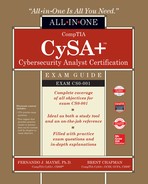Book Description
This comprehensive self-study guide offers complete coverage of the new CompTIA Cybersecurity Analyst+ certification exam
Note: This guide has been updated to reflect CompTIA's exam acronym CySA+.
This highly effective self-study system provides complete coverage of every objective for the challenging CompTIA CySA+ Cybersecurity Analyst exam. You'll find learning objectives at the beginning of each chapter, exam tips, in-depth explanations, and practice exam questions. All questions closely mirror those on the live test in content, format, and tone. Designed to help you pass exam CS0-001 with ease, this definitive guide also serves as an essential on-the-job reference.
Covers every topic on the exam, including:
•Threat and vulnerability management
•Conducting and analyzing reconnaissance
•Responding to network-based threats
•Securing a cooperate network
•Cyber incident response
•Determining the impact of incidents
•Preparing the incident response toolkit
•Security architectures
•Policies, procedures, and controls
•Assuring identity and access management
•Putting in compensating controls
•Secure software development
Electronic content includes:
•200 practice questions
•Secured book PDF
